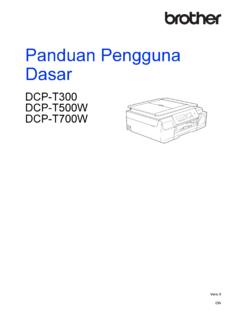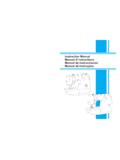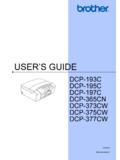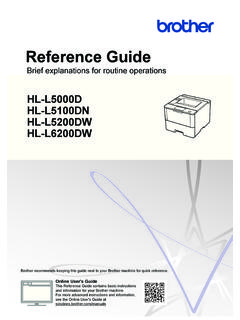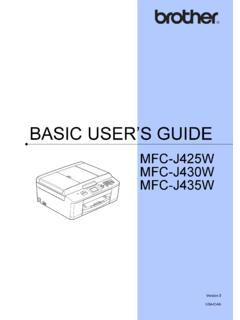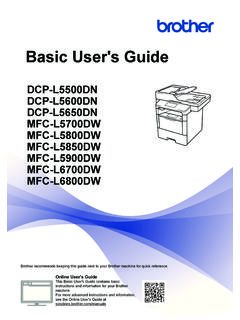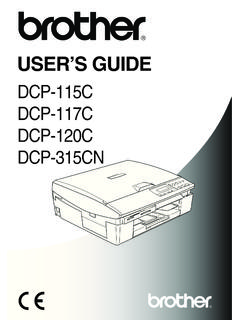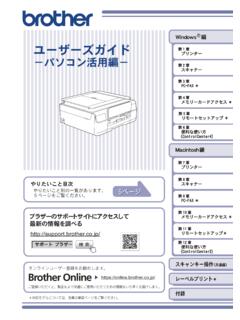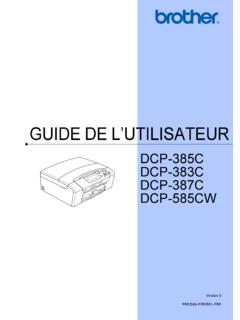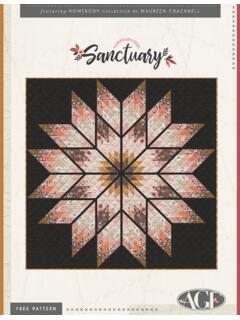Transcription of Basic Quilting Guide – Making a Quilt
1 1 Basic Quilting Guide Making a Quilt cFabric .. We recommend 100% cotton that is not too batting .. Normally, medium-thick 100% polyester batting is used. There is also cotton .. Since there are various types, for example, for piecing, for Quilting , for hand-sewing and for machine-sewing, select the type appropriate for the desired purpose and Since there are various types, for example, for piecing and for Quilting , select the type appropriate for the desired pencil (erasable pen, etc.) .. Use to copy patterns onto fabric and to draw Quilting .. Use to protect your fingers when a thimble on the middle finger of your right hand to push the needle and on the middle or index finger of your left hand to stop the hoop.
2 Use the hoop for Quilting with a cleaner clippercIron/presscMeasuring stick1 Preparing Materials and Equipment2 Refer to Cutting Around Drawings in the Operation Manual to specify a seam allowance and draw the pattern lines, and then cut out the pieces. Be sure to observe the following the fabric grain (weaving direction).* When Making pieces from patterned fabric, the pattern has priority over the fabric grain.* Observe the fabric grain on the pattern if it is a seam allowance will be drawn, attach the fabric with the wrong side facing the lengthwise grain with the insertion the patterns, and then arrange them.
3 If the fabric grain and pattern angle are not aligned, rotate the pattern.* Pre-installed patterns will automatically be arranged with their grain along the lengthwise grain of the the seam allowance. Widths that can be specified with this machine: 3 mm, 5mm, 1/4", 7mm, 10mm, 1/2", 5/8"1 Stitching line2 Seam allowance2 Cutting Pieces (Fabric)Lengthwise-grain fabricHard to stretchCrosswise-grain fabricSlightly stretchedBias-grain fabricEasy to stretch1 Lengthwise-grain fabric2 Crosswise-grain fabric3 Bias-grain fabric4 Selvage1 Standard mat 2 High tack adhesive fabric support sheet (An additional purchase may be required depending on the machine model.)
4 3 Wrong side of fabricStandard seam allowancePatchwork5 mm (3/16"), 1/4", 7 mmAppliqu 3 mm (1/8"), 5 mm (3/16") 3 Memo If you are using a sewing machine to make the Quilt , refer to your machine s instruction manual for information about the straight stitch, reverse/reinforcement stitch and appliqu stitch. When sewing pieces together without sewing reverse/reinforcement stitches, sew fine stitches, which have a short stitch a knot at the end of the thread to secure the thread 2 or 3 times around the the wound thread and pull out the knot3 Use scissors to cut off any excess fine stitches when sewing pieces mm (1/16 inch)
5 Attach appliqu s so that threads are the needle2 Feed out the needleAt the beginning and end of stitching, sew one backstitch, and then secure the thread to prevent it from becoming out the needle2 Insert the needle3 Feed out the needle4 BackstitchAt the end of stitching, sew a backstitch, make a knot, and then cut the the needle at the end of the thread twice around the needle, hold the wound thread with your finger, and then pull out the Basic Hand Sewing TechniquesThread knotRunning stitchBlindstitchBackstitchFrench knot4 When sewing pieces together, sew to the corner of the stitching the pieces together.
6 At the beginning of stitching, make a knot in the thread, insert the needle in front of the stitching line, and then sew one side of fabric2 Stitching line2At the end of stitching, sew one backstitch, and then make a french knot at the side of fabric2 Stitching line3 End pointContinuously sew together multiple pieces of fabric by sewing each side without cutting the pieces A and B together. At the end point, pass the needle to the opposite side of A .1 End point2 Feed the needle out to the end point of point3 Overlap A and B, and then continue starting or ending pointSet in seam:Right side of fabric:Wrong side of fabricABA ABA ABABA 5 Using two types of fabric, prepare 4 square pieces from one and 5 from the other.
7 (Refer to the illustration below.)Cut the pieces with a seam allowance.<Finished design>1 Sew pieces together into over seam allowances in alternating allowance2 Sew the rows together to complete the pieces with their right sides together, and then pin the beginning of stitching, insert the needle one stitch in front of the stitching sides together2 Stitching line3 Pin4 Thread knot2 Sew one backstitch, and then continue sewing a running knot2 Backstitches3At the end of the stitching, sew one a French knot2 Thread knot4 Sewing Pieces Together to Make the Top (Patchwork)Sewing orderBABABABAA 4 5 BABABABAABABABABAAS ewing method6<Finished design>1 Cut the appliqu pieces with a seam allowance applied.
8 (Example: 4 hearts)2 Make cuts 1 mm (1/16 inch) from the stitching mm (1/16 inch)Note Make more cuts in tight the pattern on the appliqu piece, and then fold over the seam allowance using an iron or side of fabric2 Cut3 Stitching line4 Pattern5 Right side of fabric4 Mark the base the pattern, and then place the appliqu piece on the base side of fabric6 Attach the appliqu piece to the base fabric with appliqu s 7 After the top (patchwork) is finished, draw the Quilting a Quilting pencil or erasable pen to lightly draw the with a light color on dark gridQuilt a diagonal grid.
9 This is frequently used to securely sew the fabric parallel diagonal at the edge of the pieces on the sides where the seam allowance was not folded 3 to 4 mm (1/8 to 3/16 inch) inside the edge of each a vertical and a horizontal line through the center of each Drawing Quilting LinesSample Quilting lines8 After drawing the Quilting lines, overlap the backing fabric, Quilt batting and top (patchwork), in order, and then baste them Quilt batting and backing fabric 3 to 4 cm (1-3/16 to 1-9/16 inches) larger than the top, overlap the three layers, and then secure them with side of fabric2 Quilt batting3 Top4 Pin2 From the center to the outside, baste a grid pattern in the order shown in the illustration.
10 At the beginning of stitching, make a thread knot. At the end of stitching, sew a backstitch, and then cut the of stitching2 Backstitch* When Quilting small items, basting pins can also be Basting(1)(2)(3)(4)(5)(6)(7)(8)(9)(11)(1 0)(12) 9 From the center to the outside, sew symmetrically in the order shown in the of stitching1 Insert the needle a short distance from the beginning, and then pull the thread to bring the knot between the top and backing fabric in order to hide the beginning of stitching, sew one sure to pass the needle through the three layers (top, Quilt batting and backing fabric)
